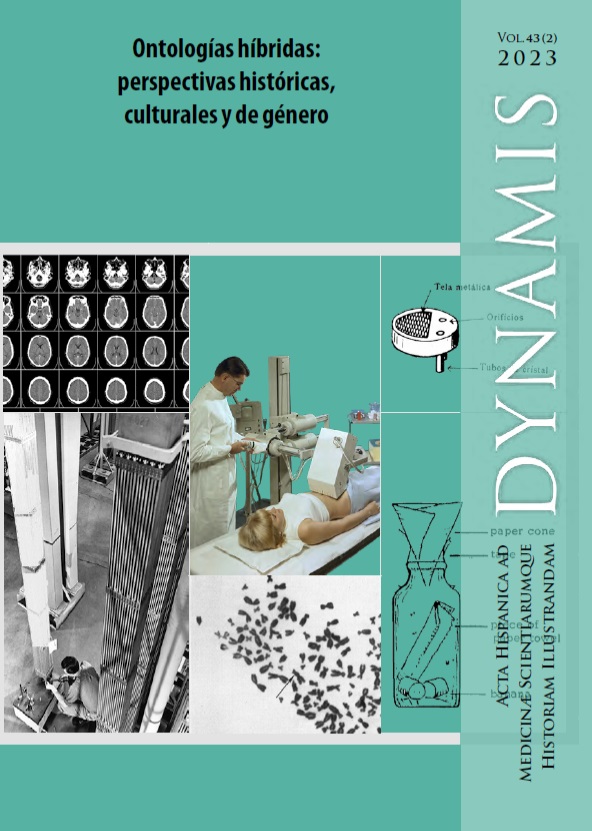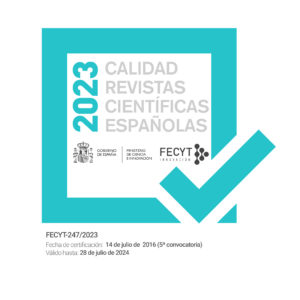Ontologías híbridas: materiales, culturas experimentales y género
DOI:
https://doi.org/10.30827/dynamis.v43i2.29440Resumen
Cuando en
Nunca fuimos modernosBruno Latour mostró el poco recorrido que tenía la polaridad clásica —el sujeto frente al objeto, lo social frente a lo natural— para pensar los distintos problemas que plantean las sociedades contemporáneas, puso sobre la mesados cuestiones claves que centraron su crítica a la modernidad. La primera tiene que ver con el ocultamiento que ese análisis polarizado hacía del carácter político y cultural que conlleva toda forma de conocer. Y la segunda con la incapacidad que estas dicotomías tienen para incorporar muchos objetos que, al convivir en ellos lo natural y lo cultural, son dif íciles de encajar. A estos objetos que Bruno Latour llamó híbridos está dedicado este monográfico.
Descargas
Citas
Bauer, Susanne; Martina Schlünder, Maria Rentetzi. Boxes: A Field Guide. Manchester: Mattering Press, 2020.
Bud, Robert. “Strategy in American cancer research after World War II: A case study”, Social Studies of Science 8, no .4 (1978): 425-459. DOI: https://doi.org/10.1177/030631277800800402
Bud, Robert, Deborah Warner, eds. Instruments of science: An historical encyclopedia.
Londres-Nueva York: Garland, 1998.
Cabré, Montserrat. “Women or healers? Household practices and the categories of health care in late medieval Iberia”. Bulletin of the History of Medicine (2008): 18-51. DOI: https://doi.org/10.1353/bhm.2008.0040
Daston, Lorraine (ed.). Biographies of scientific objects. Chicago: University of Chicago Press, 2000.
Daston, Lorraine. “On scientific observation.” Isis 99, no. 1 (2008): 97-110. DOI: https://doi.org/10.1086/587535
Duden, Barbara. Disembodying women: Perspectives on pregnancy and the unborn. Cam- bridge, MA: Harvard University Press, 1993.
Duden, Barbara. The woman beneath the skin: A doctor’s patients in eighteenth-century Germany. Cambridge, MA: Harvard University Press, 1991.
Dupré, Sven; Christoph Herbert, ed. Silent messengers: the circulation of material objects of knowledge in the early modern Low Countries. Münster: LIT Verlag, 2011.
Edgerton, David. “From innovation to use: Ten eclectic theses on the historiography of technology.” History and Technology 16, no. 2 (1999): 111-136. DOI: https://doi.org/10.1080/07341519908581961
Gooding, David, Trevor Pinch, y Simon Schaffer, eds. The uses of experiment: Studies in the natural sciences. Cambridge: Cambridge University Press, 1989.
Hannan, Leonie y Sarah Longair. History through material culture. Manchester: Man- chester University Press, 2020. DOI: https://doi.org/10.7765/9781526153418
Haraway, Donna. “Situated knowledges: The science question in feminism and the privilege of partial perspective”. Feminist studies 14, no. 3 (1988): 575-599. DOI: https://doi.org/10.2307/3178066
Hopwood, Nick, Rebecca Flemming, and Lauren Kassell, eds. Reproduction: Antiquity to the Present Day. Cambridge: Cambridge University Press, 2018. DOI: https://doi.org/10.1017/9781107705647
Iliffe, Rob. “Technicians”, Notes & Records of Royal Society 62 (2008): 3-16. DOI: https://doi.org/10.1098/rsnr.2007.0053
Kohler, Robert E. Lords of the fly: Drosophila genetics and the experimental life. Chicago: University of Chicago Press, 1994.
Krige, John. “Hybrid knowledge: the transnational co-production of the gas centrifuge for uranium enrichment in the 1960s”. The British Journal for the History of Science 45, no. 3 (2012): 337-357. DOI: https://doi.org/10.1017/S0007087412000350
Latour, Bruno. Nunca fuimos modernos. Trad. Víctor Goldstein. Madrid: Siglo XXI, 2022. Le Guin, Ursula K. “The carrier bag theory of fiction.” En Dancing at the Edge of the World: Thoughts on Words, Women, Places (New York: Grove Press), 1989, 165-170.
Lightman, Bernard, Gordon McOuat, Larry Stewart. The circulation of knowledge bet- ween Britain, India and China: The early-modern world to the twentieth century. Leiden: Brill, 2013. DOI: https://doi.org/10.1163/9789004251410
López-Beltrán, Carlos y Vivette García Deister. “Aproximaciones científicas al mestizo mexicano.” Historia, ciencias, saude-manguinhos 20, no. 2 (2013): 391-410. DOI: https://doi.org/10.1590/S0104-597020130002000002
Łotysz, Sławomir. “Controlling the production and distribution of drugs in communist Poland.” Medicina nei Secoli: Arte e Scienza 26, no. 2 (2014): 519-56.
Lynch, Michael y Steve Woolgar. Representation in Scientific Practice. Cambridge, MA: MIT Press, 1990.
Mendel, Gregor. “Experiments in Plant Hybridisation.” Journal of the Royal Horticultural Society 26 (1901), part 1: 1-32. Translated by Charles T. Druery, with an introduc- tory note by W. Bateson from “Versuche Über Pflanzen-Hybriden”. Verhandlungen des naturforschenden Vereines zu Brünn 4 (1865): 3-47.
Müller-Wille, Staffan, and Christina Brandt, eds. Heredity explored: Between public domain and experimental science, 1850-1930. Cambridge, MA: MIT Press, 2016.
Mol, Annemarie. The body multiple. Durham: Duke University Press, 2003. Olby, Robert Cecil. Origins of Mendelism. London: Constable, 1966.
Ortiz-Gómez, Teresa y María Jesús Santesmases, eds. Gendered drugs and medicine: historical and socio-cultural perspectives. Farham: Ashgate, 2014.
Pickstone, John V. Ways of Knowing: A new history of Science, Technology and Medicine. Chicago: University of Chicago Press, 2000.
Phillips, Denise, and Sharon Kingsland, eds. New perspectives on the history of life sciences and agriculture. Springer, 2015. DOI: https://doi.org/10.1007/978-3-319-12185-7
Pimentel, Juan. Testigos del mundo: ciencia, literatura y viajes en la Ilustración. Madrid: Marcial Pons Historia, 2003.
Rego Robles, Miguel Ángel. “The early drawings and prints of Santiago Ramón y Cajal: a visual epistemology of the neurosciences”. European Journal of Anatomy 23 (2019): 57-66.
Rentetzi, Maria. Trafficking materials and gendered experimental practices: radium research in early 20th century Vienna. New York: Columbia University Press, 2008.
Rheinberger, Hans-Jörg. Toward a history of epistemic things: Synthesizing proteins in the test tube. Stanford, CA: Stanford University Press, 1997.
Rheinberger, Hans-Jörg. On historicizing epistemology: an essay. Stanford: Stanford University Press, 2010.
Roberts, Lissa. “Situating science in global history: Local exchanges and networks of circulation”. Itinerario, 2009, 33 (1), pp. 9-30. DOI: https://doi.org/10.1017/S0165115300002680
Roberts, Lissa; Simon Schaffer y Peter Dear, eds. The Mindful Hand. Inquiry and Invention from the Late Renaissance to Early Industrialisation. Amsterdam: Koninklijke Nederlandse Akademie van Wetenschappen, 2007.
Romero de Pablos, Ana. “Pioneras pero invisibles: las calculistas del Laboratorio y Taller de Investigación del Estado Mayor de la Armada”. Clepsydra, 15 (2016): 49-62.
Romero de Pablos, Ana. “Mujeres científicas en la dictadura de Franco. Trayectorias investigadoras de Piedad de la Cierva y María Aránzazu Vigón”. Arenal 24, no 2 (2017): 319-348.
Romero de Pablos, Ana. “Prensa y tecnología en la España de Franco: del secreto a la política atómica pública”. Dynamis 38, no. 1 (2018):189-218.
Romero de Pablos, Ana. “Knowledge that travelled between Italy and Spain during the Franco regime: the construction of radioactivity counters”. História, Ciências, Saúde – Manguinhos 26, no. 1 (2019a): 265-279. DOI: https://doi.org/10.1590/s0104-59702019000100015
Romero de Pablos, Ana. Las primeras centrales nucleares españolas. Actores, políticas y tecnologías. Madrid: Sociedad Nuclear Española, 2019b. http://publicaciones.sne. es/Primeras-Centrales-Nucleares-Espanolas/
Santesmases, María Jesús. “Size and the centromere: translocations and visual cultures in early human genetics.” En Making mutations: Objects, practices, contexts, eds. Luis Campos y Alexander von Schwerin (Berlin: Instituto Max Planck de Historia de la Ciencia, 2010): 189-208.
Santesmases, María Jesús. “Screening antibiotics: industrial research by CEPA and Merck in the 1950s”. Dynamis 31, no. 2 (2011): 407-427. DOI: https://doi.org/10.4321/S0211-95362011000200008
Santesmases, María Jesús. “The Bacterial Cell Wall in the Antibiotic Era: An Ontology in Transit Between Morphology and Metabolism, 1940s-1960s”. Journal of the History of Biology, 49 (2016): 3-36. DOI: https://doi.org/10.1007/s10739-015-9417-4
Santesmases, María Jesús. “Discriminación in vitro: cuerpos y cariotipos en los orígenes de la genética del síndrome de Down”. En Justicia ¿para todos? (Madrid: Plaza y Valdés, 2016), 79-91.
Santesmases, María Jesús. “Circulating biomedical images: Bodies and chromosomes in the post-eugenic era”. History of Science 55, no. 4 (2017): 395-430. DOI: https://doi.org/10.1177/0073275317701145
Santesmases, María Jesús. The circulation of penicillin in Spain: health, wealth and authority. London: Palgrave, 2018. DOI: https://doi.org/10.1007/978-3-319-69718-5
Santesmases, María Jesús y Antonio Calvo Roy. Rosalind Franklin. Madrid: Prisa, 2019. Secord, James A. “Knowledge in transit”. Isis 95, no. 4 (2004): 654-672. DOI: https://doi.org/10.1086/430657
Schaffer, Simon; Lissa Roberts, Kapil Raj & James Delbourgo, eds. The brokered world: Go-betweens and global intelligence, 1770-1820. Sagamore Beach, Massachusetts: Science History Publications, 2009.
Shapin, Steven; Simon, Schaffer. Leviathan and the air-pump: Hobbes, Boyle, and the experimental life. Princeton: Princeton University Press, 1989.
Schiebinger, Londa L. ¿Tiene sexo la mente?: las mujeres en los orígenes de la ciencia moderna. Trad. María Cóndor, Madrid: Cátedra-Instituto de la Mujer, 2004.
Tansey, E.M. “Keeping the culture alive: The laboratory technician in mid-Twentieth-Cen- tury British medical research”. Notes & Records of Royal Society 62 (2008): 77-95. DOI: https://doi.org/10.1098/rsnr.2007.0035
Velasco Martín, Marta. “Moscas y redes: María Monclús y la genética de poblaciones en España”. Arenal. Revista de historia de las mujeres 24, no. 2 (2017): 349-378.
Velasco Martín, Marta. Genética de Drosophila y género: circulación de objetos y saberes. Tesis Doctoral, Universidad de Salamanca, 2019.
Wood, Roger J.; Vítězslav Orel. “Scientific breeding in Central Europe during the early nineteenth century: background to Mendel’s later work”. Journal of the History of Biology 38, no. 2 (2005): 239-272. DOI: https://doi.org/10.1007/s10739-004-5427-3
Descargas
Publicado
Cómo citar
Número
Sección
Licencia
Derechos de autor 2023 Dynamis

Esta obra está bajo una licencia internacional Creative Commons Atribución-NoComercial-SinDerivadas 4.0.
Dynamis se encuentra adherida a una licencia Creative Commons Reconocimiento (by), la cual permite cualquier explotación de la obra, incluyendo una finalidad comercial, así como la creación de obras derivadas, la distribución de las cuales también está permitida sin ninguna restricción.

















